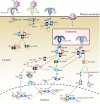Sensing of RNA viruses: a review of innate immune receptors involved in recognizing RNA virus invasion
- PMID: 22258243
- PMCID: PMC3302314
- DOI: 10.1128/JVI.05738-11
Sensing of RNA viruses: a review of innate immune receptors involved in recognizing RNA virus invasion
Abstract
Our knowledge regarding the contribution of the innate immune system in recognizing and subsequently initiating a host response to an invasion of RNA virus has been rapidly growing over the last decade. Descriptions of the receptors involved and the molecular mechanisms they employ to sense viral pathogen-associated molecular patterns have emerged in great detail. This review presents an overview of our current knowledge regarding the receptors used to detect RNA virus invasion, the molecular structures these receptors sense, and the involved downstream signaling pathways.
Figures


Similar articles
-
Mitochondrial reactive zones in antiviral innate immunity.Biochim Biophys Acta Gen Subj. 2021 Mar;1865(3):129839. doi: 10.1016/j.bbagen.2020.129839. Epub 2021 Jan 4. Biochim Biophys Acta Gen Subj. 2021. PMID: 33412226 Review.
-
Interferon induction by RNA viruses and antagonism by viral pathogens.Viruses. 2014 Dec 12;6(12):4999-5027. doi: 10.3390/v6124999. Viruses. 2014. PMID: 25514371 Free PMC article. Review.
-
Immune Responses to RNA Viruses.J Immunol Res. 2018 Jun 12;2018:5473678. doi: 10.1155/2018/5473678. eCollection 2018. J Immunol Res. 2018. PMID: 30009187 Free PMC article. No abstract available.
-
In the Crosshairs: RNA Viruses OR Complement?Front Immunol. 2020 Sep 29;11:573583. doi: 10.3389/fimmu.2020.573583. eCollection 2020. Front Immunol. 2020. PMID: 33133089 Free PMC article. Review.
-
NSUN5 Facilitates Viral RNA Recognition by RIG-I Receptor.J Immunol. 2020 Dec 15;205(12):3408-3418. doi: 10.4049/jimmunol.1901455. Epub 2020 Nov 11. J Immunol. 2020. PMID: 33177158
Cited by
-
Progress in mass spectrometry approaches to profiling protein-protein interactions in the studies of the innate immune system.J Proteins Proteom. 2024 Sep;15(3):545-559. doi: 10.1007/s42485-024-00156-6. Epub 2024 Jun 28. J Proteins Proteom. 2024. PMID: 39380887 Free PMC article.
-
A Comprehensive Review on Porcine Reproductive and Respiratory Syndrome Virus with Emphasis on Immunity.Vaccines (Basel). 2024 Aug 22;12(8):942. doi: 10.3390/vaccines12080942. Vaccines (Basel). 2024. PMID: 39204065 Free PMC article. Review.
-
Immune responses in COVID-19 patients: Insights into cytokine storms and adaptive immunity kinetics.Heliyon. 2024 Jul 14;10(14):e34577. doi: 10.1016/j.heliyon.2024.e34577. eCollection 2024 Jul 30. Heliyon. 2024. PMID: 39149061 Free PMC article. Review.
-
A parasite odyssey: An RNA virus concealed in Toxoplasma gondii.Virus Evol. 2024 May 11;10(1):veae040. doi: 10.1093/ve/veae040. eCollection 2024. Virus Evol. 2024. PMID: 38817668 Free PMC article.
-
IDO1 promotes CSFV replication by mediating tryptophan metabolism to inhibit NF-κB signaling.J Virol. 2024 Jul 23;98(7):e0045824. doi: 10.1128/jvi.00458-24. Epub 2024 May 30. J Virol. 2024. PMID: 38814067
References
-
- Akira S, Takeda K. 2004. Toll-like receptor signalling. Nat. Rev. Immunol. 4:499–511 - PubMed
-
- Akira S, Takeda K, Kaisho T. 2001. Toll-like receptors: critical proteins linking innate and acquired immunity. Nat. Immunol. 2:675–680 - PubMed
-
- Akira S, Uematsu S, Takeuchi O. 2006. Pathogen recognition and innate immunity. Cell 124:783–801 - PubMed
-
- Alexopoulou L, Holt AC, Medzhitov R, Flavell RA. 2001. Recognition of double-stranded RNA and activation of NF-kappa B by Toll-like receptor 3. Nature 413:732–738 - PubMed
Publication types
MeSH terms
Substances
LinkOut - more resources
Full Text Sources
Other Literature Sources

